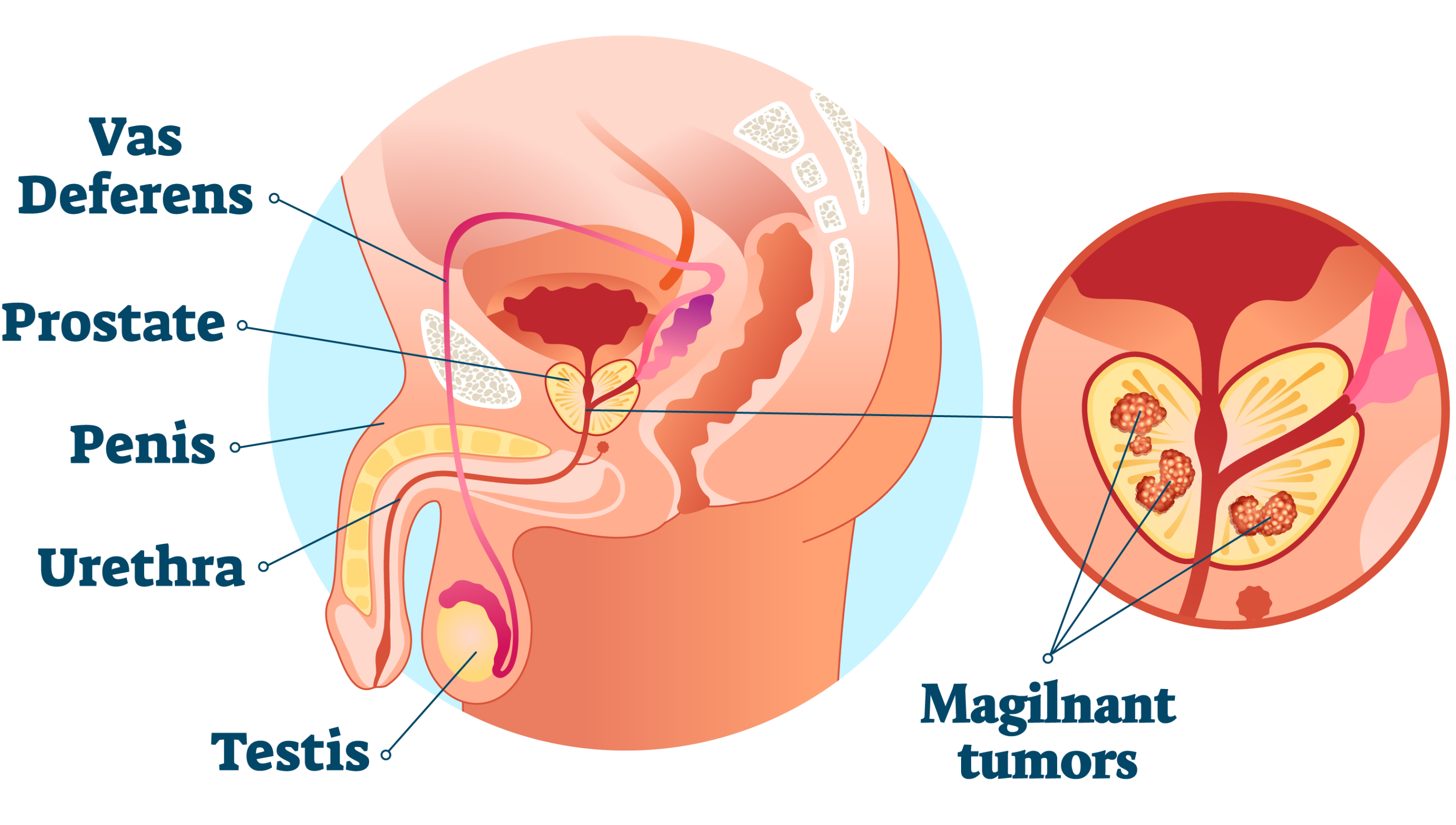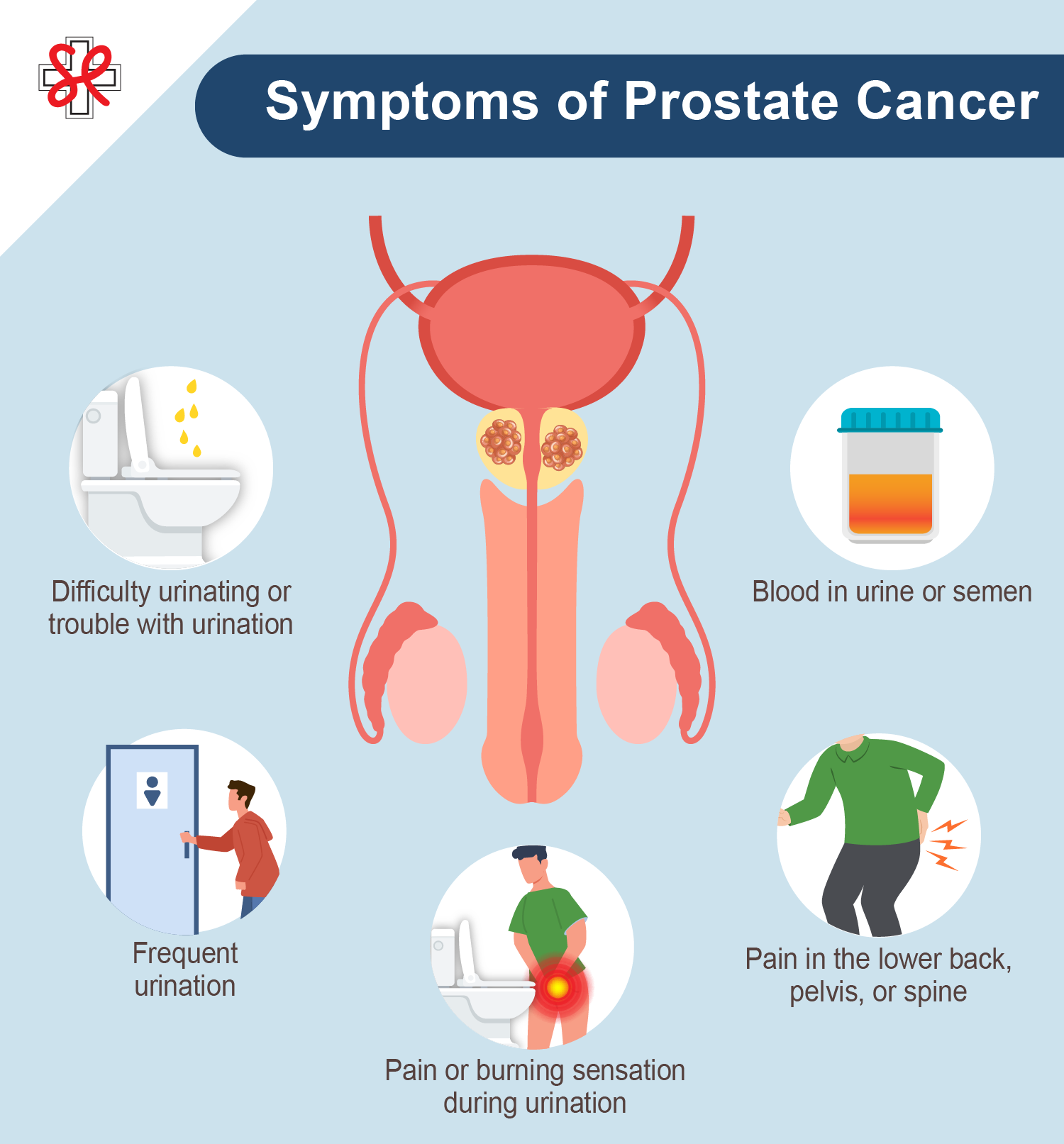The article has been reviewed Dr. Lo Hak Keung, Specialist in Urology, St. Paul's Hospital.

According to data from the Hong Kong Cancer Registry in 2022, prostate cancer is the third most common cancer among men in Hong Kong, and its mortality rate ranks fourth.1
Because the early symptoms of prostate cancer are often subtle, many people may miss the crucial window for treatment. So what exactly is prostate cancer? What are its symptoms? What are the symptoms in advanced stages? At what age does it typically occur? What treatment options are available? What does it mean if it has spread to the bones?
This article will provide a comprehensive overview of prostate cancer, helping you grasp key information, raise awareness for prevention, and respond early to safeguard your health.
About Prostate Cancer
( ![]() Click the image to enlarge )
Click the image to enlarge )
The prostate is part of the male reproductive system, it is a gland located beneath the bladder and shaped like a walnut. It contributes additional fluid to mix with and carries sperm to form semen. While benign prostatic hyperplasia is a common issue, gene mutations in prostate cells can lead to the formation of malignant tumours, known as prostate cancer.
Prostate cancer typically grows slowly, with early symptoms being subtle. As a result, many cases are only discovered in the middle to late stages. However, early screening can significantly improve treatment success rates. Cancer cells may spread to areas such as the bones and lymph nodes, if not treated in a timely manner.
Symptoms of Prostate
( ![]() Click the image to enlarge )
Click the image to enlarge )
In the early stages, there are no obvious symptoms for prostate cancer. However, as the tumour grows, the following issues may arise:
- Difficulty urinating or trouble with urination
- Pain or burning sensation during urination
- Blood in urine or semen
- Pain in the lower back, pelvis, or spine
- Frequent urination
Due to the early symptoms of prostate cancer being easily confused with benign prostatic hyperplasia, many people fail to detect it in time. If symptoms such as pain in the pelvis, back, or hips occur, it may indicate that cancer cells have spread to the bones. Therefore, regular prostate cancer screening is recommended for men. If any abnormalities are found, they should seek medical attention immediately.
Causes and Risk Factors of Prostate Cancer
The exact cause of prostate cancer is unknown, but several factors are known to potentially increase the risk of developing it. These include:
- Age : As men age, their risk of getting prostate cancer goes up; fewer cases occurring in those under 50.
- Family History: Men with family members have had prostate cancer face a higher risk of getting the disease.
- Dietary Factors: Consumption of high-fat foods may increase the risk.
Prostate Cancer Screening and Diagnosis Methods
Early screening is crucial for the detection and treatment of prostate cancer. Here are common screening and diagnostic methods:
1. Digital Rectal Examination (DRE)
For this exam, the doctor puts a lubricated gloved finger into the rectum to feel for an abnormal shape, consistency, nodularity or thickness to the gland. This method is suitable for detecting tumours close to the rectum and can provide an initial assessment of any abnormalities in the prostate.
2. Prostate-Specific Antigen Blood Test (PSA)
The PSA (Prostate-Specific Antigen) test measures the level of PSA in the blood. Elevated PSA levels may be associated with prostate cancer, benign enlargement, or infection, with higher values typically indicating a greater risk of cancer. However, the results may yield "false positives" or "false negatives," so if abnormalities are found, doctors usually recommend further examination to ensure an accurate diagnosis.
3. Trans-rectal Ultrasound Examination
The urologist will insert a small ultrasound probe (trans-rectal ultrasound) into the rectum to obtain images of the prostate. If abnormalities are detected, a biopsy will be performed. The ultrasound picture helps guide a small needle from the probe through the rectum into the prostate, where cell samples are extracted for detailed analysis.
4. Magnetic Resonance Imaging (MRI)
Magnetic Resonance Imaging (MRI) is non-invasive medical imaging technique, using strong magnetic field, radio waves and sophisticated computer technology to produce excellent images of internal structures in human body through the injection of contrast agents. It can give an accurate assessment of prostate cancer, particularly to evaluate whether cancer cells have locally spread to surrounding tissues or lymph nodes. For patients who have undergone MRI, further prostate biopsies can be performed using MRI-ultrasound fusion technology to target suspicious areas more precisely, increasing the accuracy of tissue examinations.
5. Prostate Biopsy
Guided by ultrasound or utilizing MRI and ultrasound fusion imaging, a urologist will insert a biopsy needle into the prostate to extract tissue samples. These samples are then sent to the laboratory for histological examination to determine whether tumour is present or not.
After a diagnosis of prostate cancer, the urologist will conduct further examinations to assess the cancer staging and develop a treatment plan. Additional tests may include a bone scan using radioactive isotopes or a PSMA PET-CT scan to evaluate whether cancer cells have spread.
St. Paul's Hospital Surgery Centre offers comprehensive urological examination and treatment services, equipped with the advanced medical instruments and facilities, dedicated to providing patients with a high-quality medical experience. You can make an appointment for consultation at the Surgery Centre. If you have any related urological concerns or conditions related to oncology, you will be referred to the Urology Centre, the Oncology Radiotherapy Centre, or the Oncology Day Centre for further examination and treatment. If you need urological examinations or have questions about related health issues, feel free to make an appointment to address your concerns.
Stages of Prostate Cancer and Survival Rates
Prostate cancer is primarily divided into four main stages, each with significant differences in clinical characteristics, treatment options, and survival rates. According to data from the Hong Kong Government Cancer Online Resource Hub, the overall five-year relative survival rate with prostate cancer patients was 84%, with survival rates exceeding 97% for stages I to III, while it dropped to 45% for stage IV. 2
Treatment for Prostate Cancer
Here are common treatment options for prostate cancer:
- Active Surveillance: Suitable for low-risk or slow-growing cancers, this approach involves regular monitoring through examinations. Further treatment will be initiated, if necessary.
- Surgery: Radical prostatectomy is applicable for early-stage prostate cancer, including laparoscopic / robotic-assisted surgery / open surgery. The goal is to remove all prostate cancer.
- Radiotherapy: This includes external beam radiation and brachytherapy, using high-energy rays or implanted radioactive seeds to provide long-term radiation. Radiotherapy is suitable for localised disease, postoperative recurrence or palliative treatment for metastatic disease.
- Hormonal Therapy: This treatment suppresses testosterone production or blocks its binding to cancer cells, used for advanced cancer or as adjuvant therapy.
- Targeted Therapy: This approach attacks prostate cancer cells by targeting specific genetic mutations, enhancing treatment efficacy while reducing damage to normal cells.
- Chemotherapy: This treatment involves the use of anti-cancer (cytotoxic) drugs are used to kill rapidly growing cancer cells, suitable for advanced or metastatic cancer, helping to slow disease progression and alleviate symptoms.
- Immunotherapy: This therapy utilizes the patient's own immune system to combat cancer cells, applicable for specific types of prostate cancer.
The treatment for prostate cancer depends on the stage, extent of spread, and the patient's health condition. Early-stage prostate cancer (where cancer cells have not spread) can be managed through active surveillance, surgery (radical prostatectomy), or radiotherapy. Because cancer cells grow slowly, the urologist may recommend no treatment but suggest regular check-ups, while surgery and radiation therapy can potentially cure the cancer, though the side effects differ. In cases of advanced prostate cancer, the main treatment goal is to slow down the growth of cancer cells and alleviate discomfort caused by the disease. Since each person's health condition varies, the urologist will tailor the treatment plan based on the patient's age, health status, and tumour characteristics. Patients should discuss thoroughly with their doctors to choose the most suitable option.
Post-Treatment Care for Prostate Cancer
After prostate cancer treatment, proper care is important. It not only helps speed up recovery but also effectively reduces the risk of recurrence.
- Healthy Diet: Eating more vegetables, fruits, and whole grains while reducing fat intake helps boost immunity and maintain a healthy weight.
- Regular Exercise: Engaging in moderate exercise daily helps improve fitness, strengthen immunity, and lower the risk of recurrence.
- Regular Check-ups: Follow the doctor's advice and undergo PSA tests or other examinations on schedule to monitor health status and check for recurrence.
The above information is for reference only. If you have any questions about prostate cancer, please consult a urologist.
FAQ
1.What are the early symptoms of prostate cancer?
Prostate cancer develop slowly, without obvious clinical symptom in the early stage. However, as the tumour grows, symptoms may include difficult urinating, weakened urine flow, and blood in urine or semen. Advanced symptoms may include pelvic or bone pain. It is recommended that men over age 50 or those with a family history of the disease undergo regular screening to increase the chances of early detection.
2. Who needs to undergo prostate cancer screening?
Men aged 50 or older, or those with a family history of prostate cancer, should consider prostate cancer screening. Before screening, discuss with your doctor whether related tests are necessary.
3.Can prostate cancer be cured?
According to data from the Hong Kong Government Cancer Online Resource Centre, the overall five-year relative survival rate for prostate cancer patients is 84%, with a five-year relative survival rate exceeding 97% for stages I to III. 2 Regular screening for prostate cancer allows for early detection, which improves the success rate of treatment.
Reference :
1. Hospital Authority, Hong Kong Cancer Registry, Hong Kong Cancer Statistics 2022
2.The Government of the HKSAR, Cancer Online Resource Hub, Prostate Cancer












